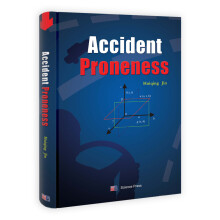Accident Proneness
作者:金会庆 著
出版:科学出版社 2013.1
页数:287
定价:128.00 元
ISBN-13:9787030373441
ISBN-10:7030373448
去豆瓣看看 Chapter 1 Accident Proneness Concept and Research Methods
1.1 Concept of Accident Proneness
1.1.1 Accidents and Theoretical Model of Accidents
1.1.2 Proposal and Connotation of Accident Proneness
1.2 Research Methods of Accident Proneness
1.2.1 Psychological Research Methods
1.2.2 Epidemiological Research Methods
1.2.3 Common Methods of Data Statistical Analysis
Chapter 2 Physiological Characteristics of Accident Proneness
2.1 Characteristics of Cardiovascular System
2.1.1 Characteristics of Heart Rate of Accident-prone Drivers
2.1.2 Characteristics of Blood Pressure of Accident-prone Drivers
2.1.3 Electrocardiogram Characteristics of Accident-prone Drivers
2.2 Characteristics of Lung Function
2.2.1 Respiratory Physiology and Altitude Sickness
2.2.2 Examination of Pulmonary Function
2.2.3 Pulmonary Function Symptom of Accident-prone Drivers
2.3 Visual Characteristics
2.3.1 Static Vision and Dynamic Vision
2.3.2 Three-dimensional Vision and Depth Vision
2.3.3 Night Vision
2.4 Auditory Features
2.4.1 Auditory Physiology
2.4.2 Hearing Impairment and Driving
Chapter 3 The Psychological and Behavioral Characteristics of Accident Proneness
3.1 Perception Characteristics
3.1.1 Perception Overview
3.1.2 The Concept of Speed Anticipation and Speed Anticipation Test
3.1.3 The Factors Affecting of Speed Anticipation
3.1.4 The Study of Drivers' Speed Anticipation
3.2 Attention Characteristics
3.2.1 The Physiological Mechanism of Attention
3.2.2 The Relation between Road Alignment and Drivers' Attention
3.2.3 The Types of Drivers' Attention
3.2.4 The Attention Quality of Drivers
3.2.5 Test of Drivers' Attention Quality
3.2.6 Study of Driver's Attention Quality
3.3 Reaction Characteristics
3.3.1 The Concept of Reaction Time and Its Classification
3.3.2 Influencing Factors of Driver's Reaction
3.3.3 Test of Driver's Reaction Characteristics
3.3.4 Discrimination Reaction Judgment and Traffic Accident
3.4 Personality Characteristics
3.4.1 Driver's Personality Measurement
3.4.2 The Driver's Personality Scale Drafting
3.4.3 Personality Characteristics of Driver and Accidents
3.4.4 The Relationship Model between Personality and Accidents
3.5 Characteriistics of Attitude
3.5.1 Concept of Safety Attitude
3.5.2 Safety Attitude Research Status
3.5.3 Formation of Driver Safety Attitude Scale
3.6 Risk Perception Characteristics
3.6.1 Risk Perception and the Relevant Concept
3.6.2 The Formation and Development of Risk Perception Theory
3.7 Stress Characteristics
3.7.1 Drivers' Stress and Its Related Concepts
3.7.2 Mechanism of Stress
3.7.3 The Driver's Stress Measurement
3.7.4 Influencing Factors of Drivers' Stress
3.7.5 The Development Tendency of Driver Stress Research
Chapter 4 The Neural Biochemical and Molecular Biological Characteristics of Accident Proneness
4.1 The Characteristics of the Neural Physiology
4.1.1 The Anatomy Basis of the Nervous Physiology
4.1.2 The Physiological Functions of the Nervous System
4.1.3 Physiological Activity Patterns of Nerve
4.1.4 Neurophysiology of the Accident Proneness
4.1.5 The Neuroendocrine Regulation of Accident Proneness
4.2 Neuro-Biochemical Characteristics
4.2.1 Neurotrausmitter and Driving
4.2.2 Hormone and Driving
4.2.3 Blood Group and Driving
4.3 Molecular Biological Characteristics of Accident Proneness
4.3.1 Overview of Susceptibility
4.3.2 Effect of Drivers' Genetic Susceptibility on Accident-prone
4.3.3 Interactions between Genetic and Environment
4.3.4 Molecular Biological Study of Accident Proneness
Chapter 5 Research and Application of Accident Proneness Theory
5.1 Theoretical basis of Accident Proneness
5.1.1 Theory of Traditional Accident Proneness
5.1.2 Three Dimension Model Hypothesis and Its Mathematical Model of Accident Proneness
5.1.3 "Three Line Defense Theory" of Traffic Accident Based on Accident Proneness Theory
5.2 Prevention and Controlling Engineering Based on "Three Line Defense" of the Traffic Accident
5.2.1 Screening of the Driver's Safety Quality
5.2.2 Detection on Drivers' Safety State before Driving
5.2.3 Comprehensive Management of High-risk Driving Environment
5.3 Engineering Application
Huiqing Jin, 1956-, male, Professor, Doctor (University of Tokyo), AccidentPrevention Specialist.Director of Chinese National Engineering Center for Vehicle Safety Driving.President of Anhui Sanlian University.President of Anhui Sanlian Accident Prevention Institute.Guest Professor of Department of Medicine, University of Tokyo, Japan.Visiting Professor of University of Kansas, USA, etc.Engaged in the traffic crashes prevention research for 30 years, Dr. Huiqing Jinhas broke through the limitations of traditional disciplines, originally developed a se-ries of studies of" etiology-pathological mechanism-prevention method" of traffic cra-shes on human factors. He discovered that there exist about 6% -8% accident-pronedrivers among drivers in China, and put forward "characteristics-period-environment"new etiology model of traffic crash, He founded" Three Lines of Defense" new theoryand methods of preventing traffic crashes in line with China's national conditions. Heproposed " Road Traffic Safety Life Security System", designed and guided the pilotproject of "Road Traffic Safety City of the UN" in Jinan city, and opened up a newdiscipline of "Road Traffic Crashes Prevention Engineering" which is to put peoplefirst. Besides more than 40 scientific and technological achievements, 5 national tech-nical standards, two achievements have been awarded respectively The First and TheSecond Prizes of National Scientific and Technological Advancement by The StateCouncil of China, 18 Chinese patents. Moreover, Dr. Jin has published more than 100academic papers and 12 publications.
This works mainly studies the characteristics of accident pronenessin physiology, psychology, behavior and genetic susceptibility, etc., andintroduces writer's great discovery of 6%~8% accident-prone drivers inChina. The works has also expounded new theory of accident pronenessof "characteristic-period-environment" three dimension model proposedby writer. The works is a classic works on anatomizing cause of trafficaccidents from a angle of human factors. The works' content mainly includes: A. The concept of accident proneness and its research methods. B. Physiological characteristics of accident proneness. C. The psychological and behavioral characteristics of accidentproneness. D. The neural biochemical and molecular biological characteristicsof accident proneness. E. Research and application of accident proneness theory. The works has originality in research and prevention on human['actors, not only provides theoretical basis for identifying accident-proneindividuals, but also supplies theoretical reference for preventing globetraffic accidents, particularly in developing countries.

 缺书网
缺书网 扫码进群
扫码进群





